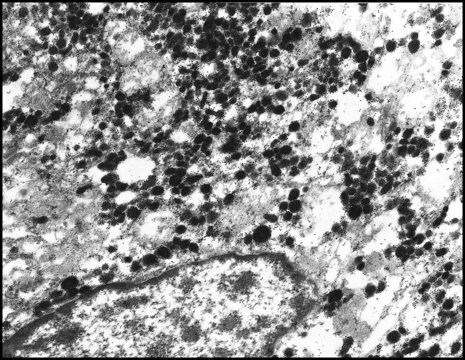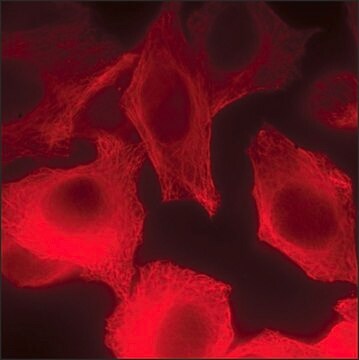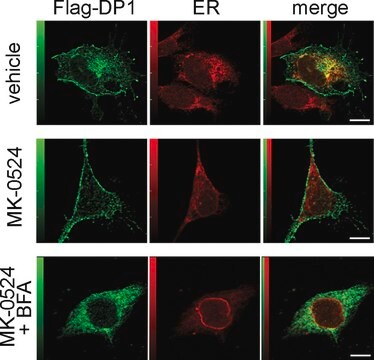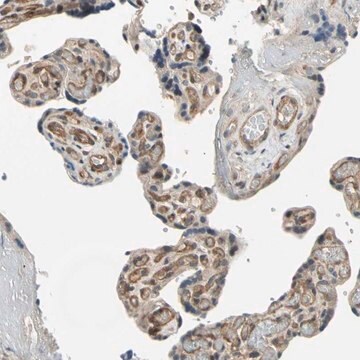G7035
Anti-Rat IgG (whole molecule)–Gold antibody produced in goat
affinity isolated antibody, aqueous glycerol suspension, 10 nm (colloidal gold)
Sign Into View Organizational & Contract Pricing
All Photos(1)
About This Item
Recommended Products
biological source
goat
conjugate
gold conjugate
antibody form
affinity isolated antibody
antibody product type
secondary antibodies
clone
polyclonal
form
aqueous glycerol suspension
particle size
10 nm (colloidal gold)
storage temp.
2-8°C
target post-translational modification
unmodified
General description
IgGs are glycoprotein antibodies that modulate several immune responses. Rat IgGs against target proteins are often used as primary antibodies in various research applications. Thus, secondary anti-rat IgG conjugated to a detectable substrate is a useful tool for the analysis of target proteins. Anti-Rat IgG (whole molecule)-Gold antibody is specific for rat immunoglobulins and does not react with human serum proteins.
Immunogen
Rat IgG purified from normal rat serum
Application
Anti-Rat IgG (whole molecule)-Gold antibody is suitable for use in dot blot assay.
Other Notes
Antibody adsorbed with human serum proteins.
Physical form
Solution in Tris buffered saline, pH 8.2, containing 1% (w/v) bovine serum albumin, 30% (v/v) glycerol, and 15 mM sodium azide.
Disclaimer
Unless otherwise stated in our catalog or other company documentation accompanying the product(s), our products are intended for research use only and are not to be used for any other purpose, which includes but is not limited to, unauthorized commercial uses, in vitro diagnostic uses, ex vivo or in vivo therapeutic uses or any type of consumption or application to humans or animals.
Not finding the right product?
Try our Product Selector Tool.
Storage Class Code
10 - Combustible liquids
WGK
nwg
Flash Point(F)
Not applicable
Flash Point(C)
Not applicable
Certificates of Analysis (COA)
Search for Certificates of Analysis (COA) by entering the products Lot/Batch Number. Lot and Batch Numbers can be found on a product’s label following the words ‘Lot’ or ‘Batch’.
Already Own This Product?
Find documentation for the products that you have recently purchased in the Document Library.
Jonathan Van Blerkom et al.
Reproductive biomedicine online, 33(4), 458-475 (2016-08-16)
The oolemma of the second metaphase mouse oocyte has a relatively large domain in the peri-polar body region that is non-permissive for sperm attachment. In this study, certain biochemical components of this non-permissive domain were examined and compared with permissive
Mathieu Bangert et al.
The Journal of infectious diseases, 205(9), 1399-1407 (2012-03-30)
New treatments against severe bacterial infections are needed because the response to antibiotic treatment is slow in acute settings and is becoming less effective owing to the emergence of antibiotic-resistant pathogens. P4-mediated antibody therapy offers a unique treatment strategy that
Patricia M Tilney et al.
PloS one, 9(5), e96405-e96405 (2014-05-09)
Secondary pollen presentation is a well-known phenomenon in the Rubiaceae with particularly conspicuous pollen presenters occurring in the tribe Vanguerieae. These knob-like structures are formed by a modification of the upper portion of the style and stigma, together known as
Chao Huang et al.
Diabetes, 67(8), 1639-1649 (2018-06-06)
Diabetic retinopathy (DR) is a microvascular complication of diabetes and is the leading cause of vision loss in working-age adults. Recent studies have implicated the complement system as a player in the development of vascular damage and progression of DR.
Agata Leszczuk et al.
Scientific reports, 10(1), 20621-20621 (2020-11-28)
Arabinogalactan proteins (AGPs) are ubiquitous cell wall and plasma membrane components and are characterised by extensive glycosylation and heterogeneity of their carbohydrate and protein units. The aim of the study was to evaluate the structural features of AGPs present in
Our team of scientists has experience in all areas of research including Life Science, Material Science, Chemical Synthesis, Chromatography, Analytical and many others.
Contact Technical Service






![CDP-Star® Disodium 2-chloro-5-(4-methoxyspiro {1,2-dioxetane-3,2′-(5′-chloro)tricyclo[3.3.1.13,7 ]decan}-4-yl)-1-phenyl phosphate](/deepweb/assets/sigmaaldrich/product/structures/224/846/d08963f5-c8ba-42e6-b4f7-9ee7fd76d809/640/d08963f5-c8ba-42e6-b4f7-9ee7fd76d809.png)

